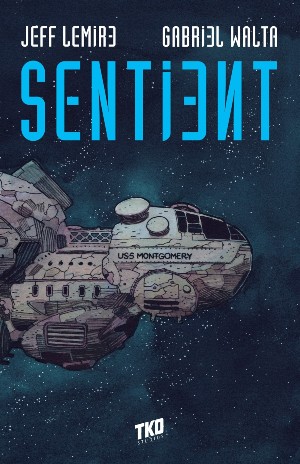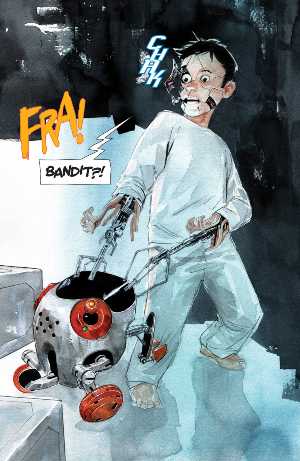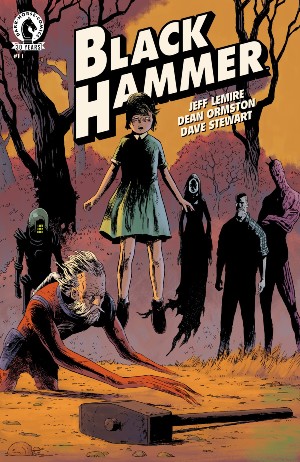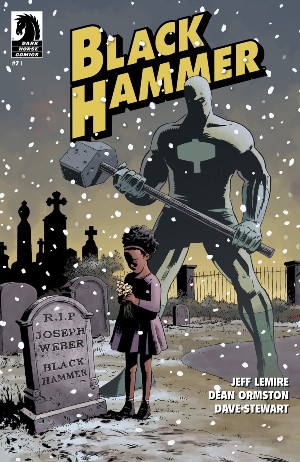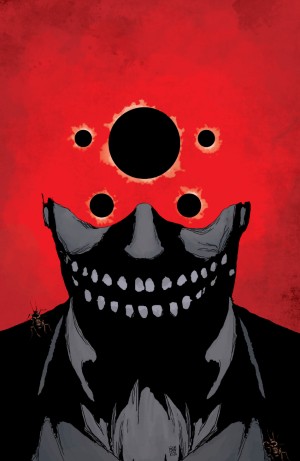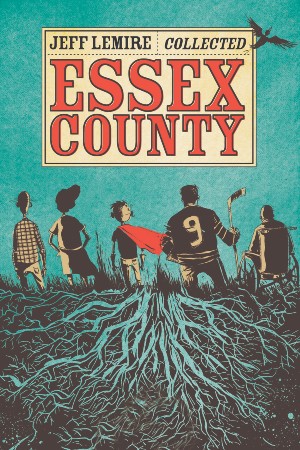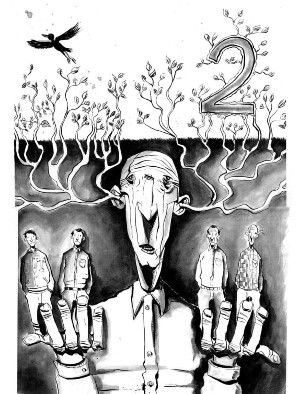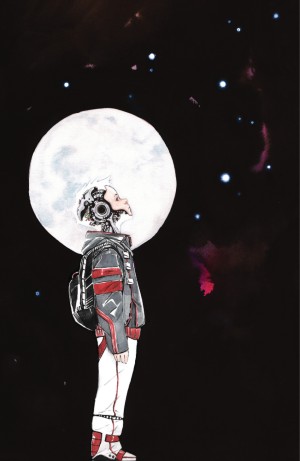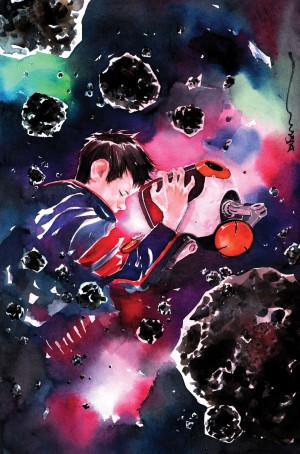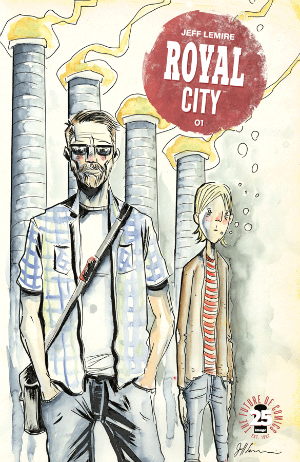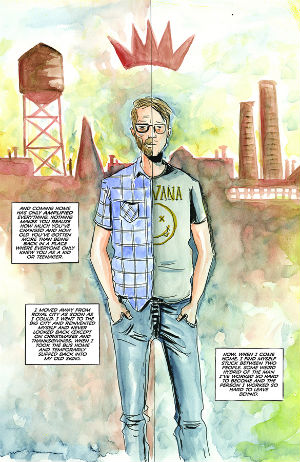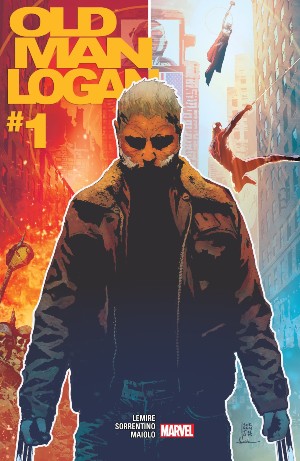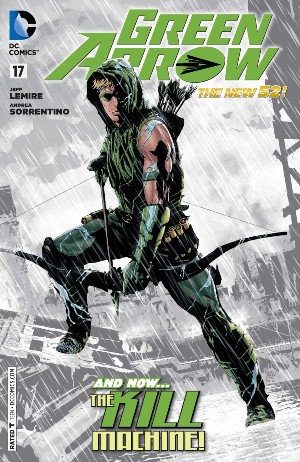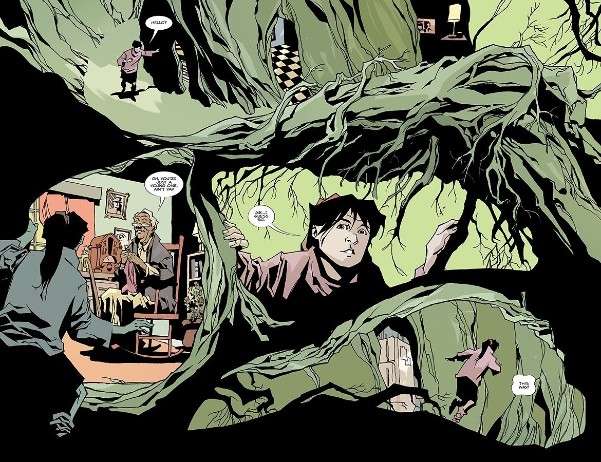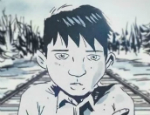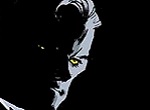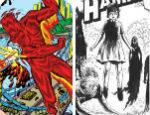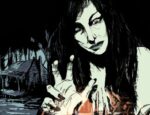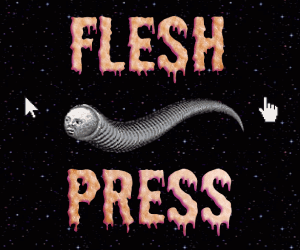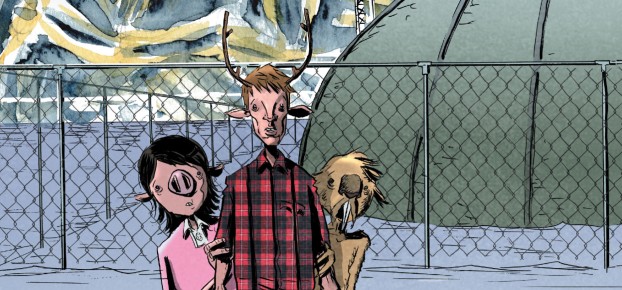
Over the past decade, few creators have been as active as Jeff Lemire. Not only the volume of work he produces is crazy, it becomes even more spectacular when you consider that his body of work encompasses a variety of genres. You can’t put Lemire in a box or narrow things to a certain niche… from science fiction and drama to horror and super-heroes, he has done it all and to great success, signified by the multiple Eisner Awards he’s gathered over the last handful of years.
Descender/Ascender, Gideon Falls, Sweet Tooth, Black Hammer and Sentient are just a few of the titles he’s wowed readers with at various publishers. From the Big Two to the independents, they all seem to want a piece of Lemire for themselves.
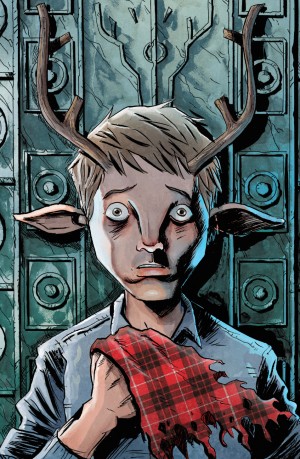 Lemire seems like a writing machine, that is, until you know that he spends the lion’s share of his time working on books he’s both writing and drawing. As he tells us, he only spends about a fifth of his time each week working on scripts for other artists.
Lemire seems like a writing machine, that is, until you know that he spends the lion’s share of his time working on books he’s both writing and drawing. As he tells us, he only spends about a fifth of his time each week working on scripts for other artists.
We had a long conversation with Lemire about his favorite projects, his creative process and how things started for him in the world of comics.
BROKEN FRONTIER: What is your writing process like? I know that process is a very individual thing, even though there are often lots of similarities with what certain writers do. So what about your process makes it typically you?
JEFF LEMIRE: My process varies greatly for projects that I am going to be drawing myself versus books I write for other artists. For the books I draw myself, it is a much looser process because the act of drawing is so labor-intensive and time-consuming that it allows for more time to think and to improvise as I go. For those books I tend to only work from a loose outline of scenes, not a full script. I’ll have a basic outline of the entire book, maybe with little bits of dialogue jotted down as they come to me. And then I’ll just work one scene at a time. I’ll thumbnail a scene, write the dialogue and then draw it, revising the script as I do.
For the books I write for others, it’s a more structured approach. I’ll start with my basic idea and I’ll usually have a general sense of an overall story shape, with an ending in mind that tells a complete story. From there I will start breaking that story down into key moments and events and build a loose outline from there. And then I just keep going over this outline again and again, identifying questions or problems or things that I don’t have figured out yet and writing those down in a separate document. These questions and problems are the key to it all, because identifying these questions and slowly figuring them out and answering them is where the story comes from. Sometimes that can take days, sometimes months. These outline documents are constantly evolving. As long as I have the basic shape of the series or story in mind I can then go off in different direction and pursue new ideas and characters as they come knowing I have a plan to fall back on.
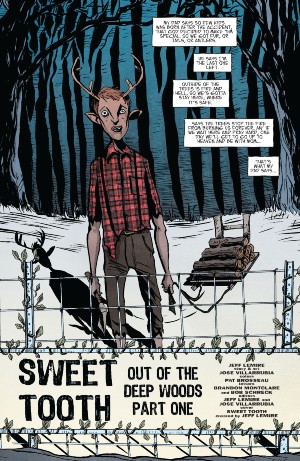
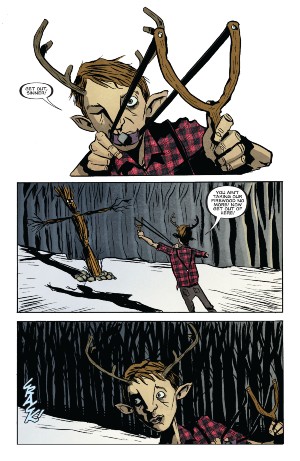
I tend to work in focused bursts. I will focus on one series or story for a couple of weeks and get all my new ideas for that book down, write a couple of scripts while my head is in that world and then put it aside before I burn out or hit a wall and move onto another book for a while. That keeps me fresh and I never have anything resembling writer’s block because I am always jumping around to whatever I’m the most engaged with creatively at that time.
The key to being able to work like this is to be really far ahead of your artists so that you have the luxury to let a book or series sit for a month or two while you recharge and get new ideas for it. When you are constantly up against deadlines you can’t do this. So I stay about 6 months to a year ahead of all my artists.
Writing the actual scripts goes very quickly once I’ve done all this groundwork. I usually write a normal sized 22-page comic script in 2-5 hours. At that point there is no problem-solving left: you can just let the characters act out the story in your head and write it down. I think having drawn so many comics myself, I don’t have to spend a lot of time breaking down the story into beats or panels, because that is all sort of instinctual at this point.
BF: On a related note, do you do a lot of research before starting a book, and what’s that usually look like? Are you someone who has to read and know a lot about a topic before diving in?
LEMIRE: No. Honestly I don’t do any research at all really. Most of the stories I write are either fantastical worlds that I create myself or are based pretty closely to my own life experiences so there is not a lot of research that goes into it. There have been a few exceptions, where a story centers on a specific period of history or some real world events that do require some reading, but I tend to the least amount of research possible, just the basic info I need to make the story feel authentic or get facts right. My stuff tends to be very character and emotional-based and that’s where my energy goes.
I know a lot of writers really enjoy research and go really heavy into it. The story can come out of all that work, but that’s never been the case for me.
Sentient with Gabriel Walta and Descender with Dustin Nguyen
BF: Seeing how you’re working on a variety of genres, from robots and sci-fi in Descender/Ascender and Sentient to personal drama with a weird twist in Sweet Tooth or Family Tree, your various superhero projects at DC and Marvel to time-travelling horror in Gideon Falls, I assume you draw your inspiration from all over the place?
LEMIRE: Absolutely. I love different elements of sci-fi and also certain types of psychological horror stories. And of course I have a real fondness for superhero stories as well. I like to work on a lot of different projects at once and I like to be able to jump between them and stay fresh. So it’s nice to have different projects that tap into different genres and different creative avenues. For that reason I also try to never have two books of the same genre going at the same time.
Having said all of that, more and more I am becoming interested in doing books that are not so easily defined by or placed into one genre. I think the most interesting aspects of my work are when different elements of horror or science fiction bleed into a more realistic setting and world. The books I am developing now for 2022 are definitely less easy to categorize as straight sci-fi or horror.
BF: What comes first for you: character or world-building/plot?
LEMIRE: Definitely character. I normally have some sort of character or loose idea for a setting and a character as well as an emotional relationship at the heart of an idea and that’s the focus. The plot and world building all come much later and are all in service of bringing out that central emotional idea or relationship. It’s sort of hard to define, but every idea has a “feeling” to it, a tone or a mood and building the story is all about keeping that feeling or mood in place. You can always tell when you come up with plot ideas that don’t “feel” right and don’t fit the world of the book and those are the ones that just become place holders and you know you will have to go back and rethink. Honestly I guess what I’m talking about is just using your intuition and instinct more than approaching the work from an intellectual place. So it’s really a character, an emotional relationship or journey and a mood that I start with, the rest comes later.
BF: How do you handle juggling so many projects at the same time, especially when you’re in a spot where you’re also drawing a book, like you’ve done recently with the return of Sweet Tooth?
The key to being able to juggle so many projects is my being really far ahead of any deadlines or ahead of your artists, so you have the luxury of putting projects aside for months at a time while you focus on other projects. As I said earlier, I am usually almost a year ahead of any deadlines or artists, so I can pick and choose what I work on. So, while I am often publishing several books at once, I am actually only working on two or three of those at any one time. I stagger them.
Drawing takes up the bulk of my week. And it is still very much my first love. Whatever project I am both writing and drawing naturally gets most of my time, as drawing is a much more time consuming and labor-intensive practice than writing. So I would say that in my Monday to Friday work week I spend about 4 days drawing for about eight hours a day and then I usually have a day a week where I sit down and just write for whatever writing project I am most engaged with that week.
I also work on a script on the weekends usually. A couple hours here and there.
These days I work from about 8am to 4pm at my studio, Monday to Friday and then a couple of hours here and there on the weekends. It’s a very structured work week and when I am home I am home, and not working. Working like this I can pencil and ink 5-7 pages a week and then write the equivalent of one script each week.
So for example, right now I am drawing a brand new project that will be published in mid-2022 and writing three other books for other artists. Each month I can do about 20-30 pages of the book I am drawing and write one or two of these other scripts.
BF: I assume you got your first big break when Chris Staros gave you the opportunity to do Essex County for Top Shelf. Do you recall what it was like breaking in, how it happened, and how do you look back on Essex County more than a decade later? It continues to be a critically acclaimed book after all.
LEMIRE: Yes, and Brett Warnock at Top Shelf also had a lot to do with that decision. That was a huge day for me. I had been struggling for five or six years at that point, making comics in a vacuum every day and working every night in a restaurant as a cook. I would draw from 8am to 3pm each day and the go to work at the restaurant where I would work from 4pm to midnight or 1am each night. I had not published anything other than a few mini-comics and had very little feedback on my work and very little contact with anyone in the comics industry. I was starting to lose faith and question the value of my work and the choices I had made in my life.
It was at this point that I started working on the first chapter of Essex County. I had been struggling with my work, it was all very derivative and lacking. And I just stripped it all down and decided to work on a story that was much more personal and autobiographical, and it felt like a real breakthrough. And when I finished that first chapter, I sent it to several publishers including Top Shelf. Chris and Brett were very complementary but had some notes and some reservations about publishing the book. But there feedback was honest and in it I also saw some validation that what I had been working on was actually of some value and close to being worthy of publishing. That really energized me, and I went back and added some new pages to the book, reflecting Chris’ editorial notes and re-submitted it to them a month or two later. I think Chris was impressed that I took his notes to heart and actually did the work to implement them and improve the book. When they finally agreed to publish the book, it was a real watershed moment for me and my career it was the start of everything for me and validated all the years of struggling alone at the drawing desk.
Descender with Dustin Nguyen
I still look back very fondly on that book. And it’s been strange because for the last several years I have been developing and writing the television adaptation for Essex County, so I am now very much back into that world and living with those characters. And revisiting it creatively like this so many years later only makes me appreciate it more, flaws and all.
BF: Looking back at your career, what are the 3 or 4 defining books for you?
LEMIRE: It’s very hard to choose favorites, as each book is special and each sort of marks a period in my life and in my creative trajectory. And of course whatever I am working on at the moment feels like the best thing I’ve done in some ways. But I can definitely look back and see that certain books elevated my career at key points and were also creative landmarks for me.
Essex County, as outlined in the last question, was a major stepping-stone for me creatively and in terms of jumpstarting my career. And in a lot of ways that book is still the template and touchstone for everything that’s come afterwards. All the themes and aesthetic concerns I am still working over are present in that book.
Sweet Tooth is probably equally as important to me. That book was instrumental in widening my body of work, I think. I was at a point where I could have just tried to replicate Essex County’s success and just kept making books like that over and over. But instead I was given the opportunity to expand into also doing genre work and doing monthly comics in addition to graphic novels. So, career-wise, it really opened things up for me and it was massive learning curve, drawing a monthly book and learning to experiment and use that format. And emotionally and creatively it remains a personal favorite. The characters and the world are still very close to my heart.
And then it gets harder to identify or rank my books because I’ve done so many different things since then. Certainly Black Hammer stands out because it was the perfect synthesis of my indie work and my more mainstream work and my love of the superhero genre and its grown into its own universe now. And Descender and Gideon Falls are also important to me and my career.
I have a real fondness for Royal City as well. It was a real return to the territory of Essex County for me, but years later and with a new perspective.
In terms of the work for hire projects I’ve done, meaning the books I don’t own for Marvel or DC, it’s much more of a mixed bag because I had less control over many of those projects so sometimes things lined up and they came out great, like with Animal Man or Moon Knight and other times the results were mixed.
BF: Speaking of defining moments, it goes without saying that you’ve developed quite the relationship with Andrea Sorrentino, having done various books together. What makes your working relationship unique? Did you instantly hit it off when you first got paired on Green Arrow for DC’s The New 52
LEMIRE: I am very fond of all the books I have done with Andrea. The work-for-hire books we did – Green Arrow, Old Man Logan and Joker – are among my favorites as far as my Marvel and DC projects, and Gideon Falls is the embodiment of our unique collaboration. As soon as we started working together on Green Arrow in 2012 we just had that undefinable chemistry that is so hard to find. I think we both like to experiment, and we both trust and respect each other. I give him all the freedom in the world to experiment and to take my scripts in different directions and then when I see what he has done, and the new ideas he has included I am quick to absorb those and work them into the story. The result is a true collaboration. This sort of back and forth is nearly impossible to find. It takes a writer that is willing to let go and not be precious and an artist that can take that freedom and actually do work that improves the story. I think we were really meant to work together and bring out the best in each other.
We immediately hit it off and I think he and I will continue to work together through our careers building our own little library of books.
BF: Is Andrea your ‘go-to’ artist now, so to speak, or do you pick artists for your creator-owned books based on style and subject matter?
LEMIRE: I am very lucky in that I have developed strong relationships with a few different artists. Andrea is definitely one of them and Dustin Nguyen, Dean Ormston and Emi Lenox are others. And recently I have forged a similar bond with Gabriel Walta. This is a pretty incredible mix of talented artists that I work well with and it opens up all sorts of doors for me. I can literally write any sort of story I want to and know that I have a collaborator that will help me fully realize the idea. And then, aside from all that I also get to write and draw my own projects. I am in an incredibly fortunate position.
So now I look to each of these artists and as I come up with new ideas, think whom they would best suit.
In the last few months I have been developing several new projects and often with the artist in mind, knowing how we work together and what kind of material they excel with.
Family Tree with Hester, Gapstur, Cody and Wands
BF: Gideon Falls wrapped up a few months ago, Family Tree is about to wrap, and I assume you and Matt Kindt already have Cosmic Detective in the can. What’s next on the creator-owned front for you, or are you going to take a breather for a bit? 🙂
LEMIRE: No breathers for me. I am not a very happy person when I am not working a lot. It’s my nature. So I keep moving. It has been a very strange transitional year for me. Aside from the pandemic, which makes everything strange to begin with. Almost all of the books that I have been doing for the last five or six years are ending around the same time; Gideon Falls and Ascender are ending, and I have been done writing them for almost a year now and even Black Hammer is heading towards a conclusion in the next couple of years. So I find myself with the time to develop a number of new projects.
Currently I am developing and writing a new longer form series for Gabriel Walta that I am very excited about. Dustin and I are doing a shorter DC project that we had been discussing for years and it’s an itch we wanted to scratch, then it will be on to our next creator-owned book which is very different from Descender.
I am also writing a new project for Andrea Sorrentino that will be very very different for us, a genre we have not tackled together yet.
And in addition to these new books I written and drawn one new graphic novel called Mazebook that will be published in September and I am now drawing my next book which is a very strange mix of the aesthetic of Essex County and with some of the elements of my more genre-based stuff. It’s not a graphic novel but also not a monthly series so I have been talking to my publisher about some unique formats and publishing ideas. Right now we are thinking it may be a 64-page quarterly publication.
These will all be books that will be published in 2022. And in addition to all this I am still writing the Essex County TV show which we hope to film this Fall in Canada.
Interview by Frederik Hautain
Follow Jeff Lemire on Twitter here





